TM-9-2350-277-34 - Page 128 of 871
TM 9-2350-277-34
PREVENTIVE MAINTENANCE CHECKS AND SERVICES (PMCS), INCLUDING
LUBRICATION INSTRUCTIONS — Continued
0014 00
o.
ELECTRICAL PARTS.
1)
Replace corroded or burned parts and parts which show signs of mildew.
2)
Tighten loose connections.
3)
Replace cracked or broken wires, circuit cards, relays, and connectors.
4)
Replace cracked, torn, or burned insulation and heat shrink tubing.
Welding Instructions
11. Welding safety precautions and welding procedures are given in the following steps. Special instructions are covered
in the task.
a.
SAFETY PRECAUTIONS.
1)
Wear clothing such as leather or heavy denim. Do not wear clothing with loose pockets, trouser cuffs,
or short or rolled up sleeves.
2)
Do not expose bare skin to welding arc.
3)
Do not look directly at welding arc unless you are wearing a welding hood.
4)
Wear flash goggles or tinted safety glasses (No. 2) in welding area.
5)
Disconnect power source before changing parts or making equipment repairs.
6)
Do not touch mechanism or any part of the electrode.
7)
Make sure welding area has plenty of fresh air without being drafty. Remove all toxic and combustible
materials.
8)
Make sure all electrical and gas connections are tight.
9)
Do not touch any metal in welding area with bare hands. Aluminum does not change color when hot.
10) Do not weld in the fuel compartment where sealing compound has been applied.
11) Use a welding screen to protect personnel from arc flash.
b.
GENERAL WELDING PROCEDURES.
1)
BASIC WELDING REPAIRS.
Repairs are made on 5083 aluminum alloy using the MIG (Gas Metal Arc)
welding method.
2)
CONTRACTION AND EXPANSION.
Aluminum welds contract about 6 percent in volume when they
become solid. Welding at slow speed may cause too much heating of the area around the weld. This will cause
the metal to expand too much or melt. It will then cause cracking upon cooling.
3)
FILLER WIRE.
Always use clean wire. Filler wire polluted by grease, oil, dust, or shop fumes causes porous
welds. After welding, cover wire to prevent pollution. Store covered wire in warm, dry place.
4)
CLEANING OF WELDED SURFACES.
Remove oxides, grease, oil films, paint, and all foreign matter
from joint before welding. Wipe edges of joint with a clean cloth dipped in cleaning compound, and let dry
before welding. Sand with disk sander, or brush surface with clean stainless steel wire brush to remove oxide.
Clean up weld area and touch up paint all bare metal. See TM 43-0139.
5)
FIT-UP AND TACKING.
Good joint fit-up makes welding easier, saves filler wire and gas, and helps get
higher quality welds. You must tack weld to hold the joint members in place if you don’t have jigs. Tack welds
should be small, neat, and placed right to keep parts lined up before and during welding.
6)
WELDING UNEQUAL SECTIONS.
When welding unequal sections, direct arc against heavier piece to
fuse the two edges evenly. Watch weld pool edge rather that arc to ensure weld pool edges fuse right.
001400-9
Change 5
Back to Top




















